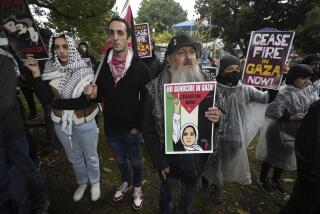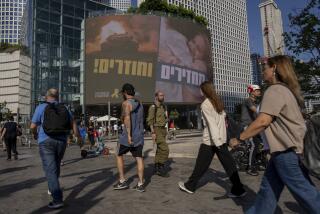Opening a Shutter on Israel
Among hundreds of events taking place throughout 1998 to mark the 50th anniversary of the state of Israel is âMicha Bar-Am: Israel, a Photobiography,â an exhibition on view at the Museum of Tolerance.
Now 68, Bar-Am has lived in Israel since 1936 and began taking pictures as a boy. Present with his camera at dozens of Israelâs historic moments, heâs compiled a vast photographic chronicle of the region.
âOne of the problems of digging into an archive of 250,000 negatives is that an archive of that size allows you to construct any story you want to tell. I admit this isnât an objective history of Israel,â Bar-Am says of the show of 150 images. âItâs a history as seen through the eyes of one photographer.â
Shot mostly in black and white, Bar-Amâs photographs are particularly thorough in regard to the many wars that have wracked the region; he was a soldier in several of them, and photographed nearly a dozen.
âAs far back as I can remember, we clashed with our neighbors--thatâs just part of Israeli life,â Bar-Am says in an interview at the museum. âIâve always been surrounded by political conflict and fighting, but oddly enough, Iâve never feared for my life and have no traumatic memories of my childhood.â
A spirited man who says his work was shaped by his sense of adventure, rather than by any political ideology, Bar-Am was present at Haifa Port on May 14, 1948, as the British withdrew from Palestine.
âIâve been fortunate to live in a time and place where historic events were occurring,â says the artist, who was 17 at the time. Bar-Am can, in fact, be spotted among the crowd witnessing this historic moment in a photograph by the legendary war photographer Robert Capa (who is the subject of a retrospective currently at San Diegoâs Museum of Photographic Arts).
The second of three children born to a Jewish couple in Berlin, Bar-Am says his father longed to emigrate to Palestine long before Hitler rose to power.
âMy father was born in Odessa [Russia] but emigrated to Germany as a young man,â says Bar-Am, who lives with his wife and two sons in Ramat Gan, outside Tel Aviv. âWhen he was in his 20s he visited Palestine and felt he was destined to live there, but returned to Germany, where he married and had children. By the mid-â30s he sensed what was to come for Germany, so in 1936 he left for Palestine.
âAs was the case with most German Jewish families, a few members of our family emigrated to America in the â30s, and they sent us American magazines,â says Bar-Am of his early exposure to photography. âAs a young boy I saw the work of photographers such as Robert Capa and Walker Evans, and I started taking pictures when I was 12.
âI was also influenced by a book written by Langston Hughes with photographs by Roy DeCarava called âThe Sweet Flypaper of Life.â The combination of words and images produces something greater than the sum of its parts, and Iâve always put a lot of thought into the captions that accompany my pictures.
âAs a teenager, I dreamed of having a 35mm Leica, but in 1949 I joined a kibbutz [an Israeli collective], where such a purchase wouldâve been considered an inappropriate extravagance,â adds Bar-Am, who is self-taught. âSo I worked with cameras lent by my friends until 1954, when I finally got my own camera.â
âI spent those [kibbutz] years working in the fields, the welding shop and the stone quarry, and as a youth instructor and mounted guard,â Bar-Am recalls. âKibbutzim usually settled on a border so they could also serve security purposes, and I settled with my friends on the Lebanese border.â
Bar-Am left the kibbutz in 1955 to participate in a series of archeological expeditions in the Judean desert.
âPeople in Israel were looking for roots,â he recalls, âso after the 1947 discovery of the Dead Sea Scrolls, everyone became interested in archeology. Searching in caves and finding pieces of parchment you could read meant the language hadnât changed much in thousands of years, and that had profound meaning for us.â
In 1956 Bar-Am attached himself to a reconnaissance unit in the Sinai Campaign and produced the material for his first book, âAcross Sinai,â which was published in 1956.
âYou donât think about the danger when youâre photographing a war,â says Bar-Am, who began making a living as a photographer in 1957 when he joined the staff of the Israeli weekly magazine Bamahaneh. âYouâre aware that bullets donât discriminate between soldiers and photographers, but when youâre in the middle of an artillery barrage, you do what you can do best, which is take pictures.â
During Bar-Amâs nine-year stint at Bamahaneh, he covered the trial of Adolf Eichmann, the notorious war criminal who was captured in Argentina in 1960 and tried in 1961 in Israel, where he was executed the following year.
âWe in Israel heard about horrible things, and members of my family disappeared in the camps, but most Israelis didnât feel the full impact of the Holocaust until the trial of Eichmann,â says Bar-Am of the first televised trial in history. âThis was the moment we became fully aware of the Holocaust, and Eichmannâs trial launched Israel on a process of soul-searching that hasnât finished yet.â
Bar-Am covered a lot of ground during his years at Bamahaneh. He was in Vietnam in 1961, âjust as the Americans were getting into the mud there,â he says. He accompanied David Ben-Gurion on a meditation pilgrimage to the Far East in the early â60s, traveled throughout West Africa in 1959, and spent time in Arab villages (Arabic is one of several languages Bar-Am speaks).
However, Bar-Am feels that it wasnât until 1966, when he left Bamahaneh, that his work began to soar. It was then, he recalls, âthat I became interested in the theoretical aspects of photography and began studying the work of Man Ray.
âMost photographers have 10 best years, and mine began in 1967 with the Six-Day War. My maturity as an artist, and the drama of the events I was photographing converged then in an interesting way,â continues the artist, who established the photography department at the Tel Aviv Museum of Art in 1977 and is a founding member of the International Center for Photography in New York.
Asked about the current political climate in Israel, Bar-Am grows somber.
âThe 1995 assassination of Prime Minister Yitzhak Rabin affected me deeply,â he replies. âI knew him personally and that one Jew could kill another left many Israelis, including myself, wondering if the situation in our country can ever get better. Since Rabinâs assassination I look at things differently. Iâm more pessimistic, Iâm sorry to say.
âItâs strange the way Israel elicits such an opinionated response from people,â he adds. âPeople tend to be very passionate about it, and everybody knows better than you what Israel should be about. Thatâs something you have to live with, and Iâve learned not to argue with people about it.â
*
âMICHA BAR-AM: ISRAEL, A PHOTOBIOGRAPHY,â Museum of Tolerance, Simon Wiesenthal Center, 9786 W. Pico Blvd. Dates: Mondays to Thursdays, 10 a.m.-5 p.m.; Fridays, 10 a.m.-4 p.m.; Sundays, 11 a.m.-6 p.m. Ends Oct. 25. Prices: Adults, $8; seniors, $6; students, $5; children, $3. Phone: (310) 553-8403.
PROTEST: At the Western Wall, an Orthodox Jewish extremist lobs back a smoke canister that he caught after it was hurled by police.
CULTURAL: Sunbathers and a Bedouin share Taba beach in Sinai in 1982 near the Egypt-Israel border.
More to Read
The biggest entertainment stories
Get our big stories about Hollywood, film, television, music, arts, culture and more right in your inbox as soon as they publish.
You may occasionally receive promotional content from the Los Angeles Times.










